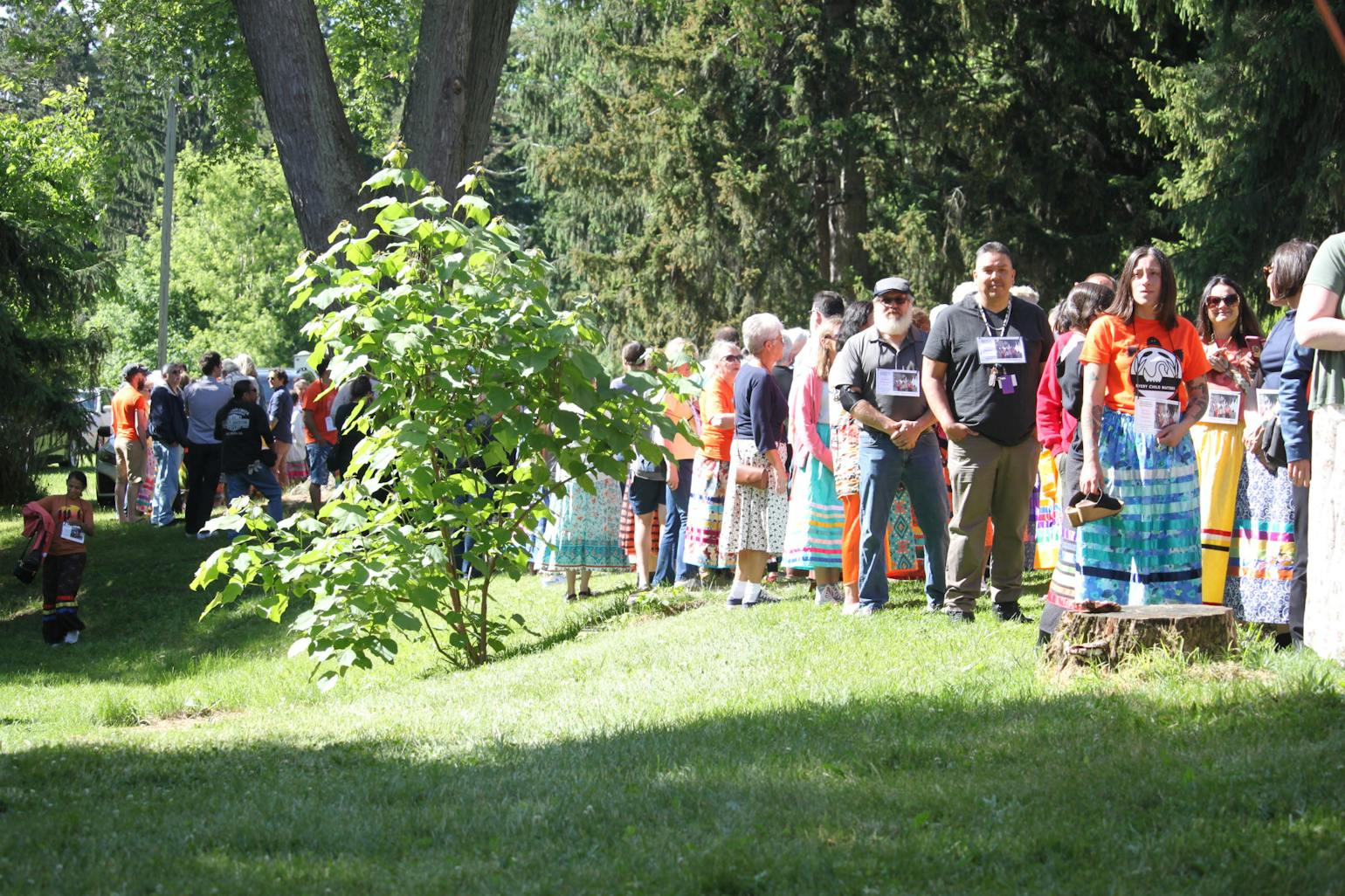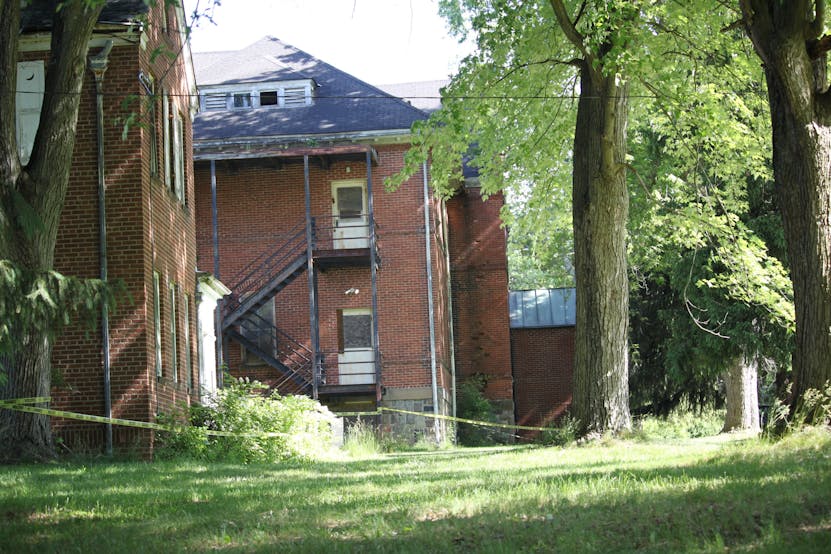'All the pain is being lifted'
Honoring, Healing and Remembering pays homage to industrial boarding school students

Flag bearers from throughout the Great Lakes Region lead more than 200 volunteers in the Grand Entrance for the Honoring, Healing and Remembering event Thursday, June 6, at the campus for the former Mount Pleasant Indian Industrial School. The event took place on the 90th anniversary of the school's closing and participants such as Brenda Taylor (foreground, far right) marched in honor of the 227 known students who died at the school during its nearly four-decades of operation. The exact number of students who died is not known.
Vivian Chatfield-Taylor spent more than two decades searching for a sense of community.
The 78-year-old Pontiac woman was taken from her mother as an infant and made a warden of the state. She was passed from family to family, she said, and late in the 1990s, decided to reclaim her Indigenous heritage and roots.
On Thursday, as she marched with a more than 200 fellow volunteers from throughout the Great Lakes Region, her search circled closer to its conclusion.
Chatfield-Taylor, a soft-spoken, thoughtful woman with a warm smile and family members who were part of the Saginaw Chippewa Indian Tribe, wore a placard around her neck honoring one of the 227 known Native American children who died while attending the Mount Pleasant Indian Industrial School. (The exact number of student victims is still unknown). A community of volunteers, survivors and descendants, generations-deep, marched across the cloud-and-leaf-dappled campus grounds for the Grand Entrance of the annual Honoring, Healing and Remembering event on the school grounds.
“It was awful what they did to us,” Chatfield-Taylor, said in a quiet voice. “I was originally told I should come here. I came … without my roots.”
Her daughter, Schantell Taylor, grew teary-eyed as she watched her mother march and stand at attention for the opening prayer.
“It is just such an honor to do this for her,” Taylor said. “She’s been searching for years and years and years and years.”

"Memorial is only powerful insofar as people are coming together to inspect it, to care about it, to think about it, to remember, to read the names."
-- Christan Nakarado
Assistant professor of design and engineering studies at Wesleyan University, chief architect of the Mount Pleasant Indian Industrial School and member of the Sault St. Marie Tribe of Chippewa Indians
A time to honor
The annual Honoring, Healing and Remembering event is a day-long commemoration baying tribute to the children who passed through the school’s walls, offering support, community and healing for their survivors and descendants, and looking forward at how advocates and leaders plan to turn the campus from a place of lost identities into one of cultural reclamation.
The boarding school operated on some 320 acres from June 30, 1893, to June 6, 1934, according to the Ziibiwing Center of Anishinabe Culture & Lifeways, with an average enrollment of 300 students per year. Thursday’s event took place on the 90th anniversary of the institution’s closing.
Suzanne Cross, an associate professor emeritus at Michigan State University’s School of Social Work, tribal researcher and consultant, and member of the Saginaw Chippewa Indian Tribe, detailed the conditions at the Mount Pleasant school, where her mother was a student from 1920 to 1927.
“When my mother, aunty and uncle arrived at the (school) they were immediately separated into age and gender groups,” Cross said during a speech at the gathering. “Their hair (was) cut crudely and short, (and they were) stripped of their traditional clothing, including their sacred, protective items, which were discarded in a fire.”
Students were subjected to physical, emotional and sexual abuse at the hands of the authorities, Cross said. She said misbehavior was met with harsh punishments that ranged from public beatings to forced isolation, and from being deprived of food to being assigned extreme cleaning responsibilities.
That degree of trauma leaves scars that resonate through generations, Cross said. But from her resilient, strong and spirited mother, she also learned some very positive lessons, including self-reliance, perseverance and the importance of a plan.
“I learned a different Native American history than the children at the school I attended,” she said. “I also learned survival skills, which include to honor and keep your children close to you.
“Wounds heal,” she told the attendees. “Mothers and daughters can be close, despite the boarding school experience, and yes, most of all, protecting my spirit.”

A plan for the future
In 2018, the National Park Service placed the campus on its National Register of Historic Places, and with the help of architect Christan Nakarado and federal grant funding, the school is in being renovated into a space for healing.
Nakarado, an assistant professor of design and engineering studies at Wesleyan University in Middletown, Connecticut, and member of the Sault St. Marie Tribe of Chippewa Indians, detailed a plan to repurpose the campus workshop, gymnasium and classroom building.
The campus, he said, was built for the purpose of removal – removing children from their families, their language, their history and their culture.
“We want to turn that around 180 degrees and make that about return,” he said. “We want to make this a place where all of those things return.
“A place for culture, a place for memorial … a place of remembrance.”
The plan emphasizes language revitalization and storytelling; traditional and contemporary arts; healing; treatment from generational trauma; and a natural, living memorial site.
“These buildings, once they are made safer, can actually function as a museum themselves,” he said, noting that they don’t need to be climate controlled and house curated exhibits to be impactful.
“The message we want to send and the things that we have been saying is we want silence inside these buildings. The silence can speak to us.”
For the memorial, Nakarado said, incorporating nature and the living spirit of the community would be critical to the final design, whether it be a memorial garden or a natural monument.
“Every time I’m here, I think HHR is the best memorial -- coming together as a community,” he said. “Memorial is only powerful insofar as people are coming together to inspect it, to care about it, to think about it, to remember, to read the names. That’s what we want to do. We want to figure out how to embody HHR, not just for one day but for every day.

Light over darkness
For Brenda Reynolds, that’s part of healing not just her own spirit, but the soul of the space itself.
Reynolds is an elder with the Pokagon Band of Pottawatomi Indians. A deeply empathic woman and descendent of boarding school survivors, she was proud to participate in the grand entrance march while paying homage to 8-year-old victim Allison Peters.
“These teens and children, we are honoring them, we remember them,” she said.
This year marked her second trip from her Dowagiac home for the commemoration. Last year, she said, she broke down under the weight and sadness of the space.
But on the 90th anniversary of the end of a dark era, she said, she felt a new lightness and love. She believed that the spirits of the unknown number of children who died on the campus appreciated being remembered and loved by the family members who gathered to honor them.
“Today is different,” she said. “I feel really blessed here today. It’s a beautiful feeling.
“It’s embodying the love and respect for (them), so all the pain is being lifted.”






